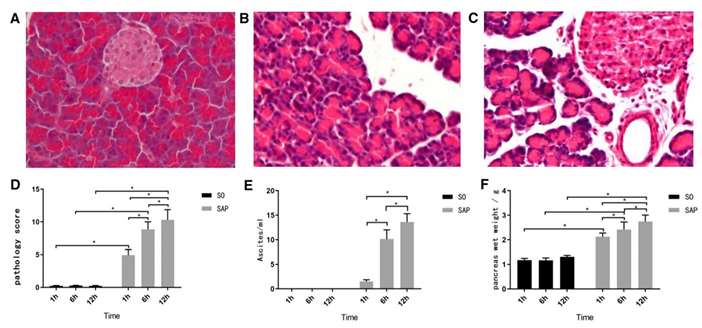- You are here: Home
- Disease Models
- Digestive Disease Models
- Pancreatitis Model
- Sodium Taurocholate-Induced Pancreatitis Model
Disease Models
- Oncology Models
-
Inflammation & Autoimmune Disease Models
- Rheumatoid Arthritis Models
- Glomerulonephritis Models
- Multiple Sclerosis (MS) Models
- Ocular Inflammation Models
- Sjögren's Syndrome Model
- LPS-induced Acute Lung Injury Model
- Peritonitis Models
- Passive Cutaneous Anaphylaxis Model
- Delayed-Type Hypersensitivity (DTH) Models
- Inflammatory Bowel Disease Models
- Systemic Lupus Erythematosus Animal Models
- Asthma Model
- Sepsis Model
- Psoriasis Model
- Atopic Dermatitis (AD) Model
- Scleroderma Model
- Gouty Arthritis Model
- Carrageenan-Induced Air Pouch Synovitis Model
- Carrageenan-Induced Paw Edema Model
- Experimental Autoimmune Myasthenia Gravis (EAMG) Model
- Cardiovascular Disease Models
-
Neurological Disease Models
- Alzheimer's Disease Modeling and Assays
- Seizure Models
- Parkinson's Disease Models
- Ischemic Stroke Models
- Acute Spinal Cord Injury (ASCI) Model
- Traumatic Brain Injury (TBI) Model
- Hypoxic-Ischemic Encephalopathy (HIE) Model
- Tourette Syndrome (TS) Model
- Amyotrophic Lateral Sclerosis (ALS) Model
- Huntington's Disease (HD) Model
- Intracerebral hemorrhage (ICH) Models
- Pain Models
- Metabolic Disease Models
- Liver Disease Models
- Rare Disease Models
- Respiratory Disease Models
- Digestive Disease Models
-
Urology Disease Models
- Cisplatin-induced Nephrotoxicity Model
- Unilateral Ureteral Obstruction Model
- 5/6 Nephrectomy Model
- Renal Ischemia-Reperfusion Injury (RIRI) Model
- Diabetic Nephropathy (DN) Models
- Passive Heymann Nephritis (PHN) Model
- Adenine-Induced Chronic Kidney Disease (CKD) Model
- Kidney Stone Model
- Doxorubicin-Induced Nephropathy Model
- Orthopedic Disease Models
- Ocular Disease Models
Sodium Taurocholate-Induced Pancreatitis Model
Creative Bioarray is a leading biotech company that specializes in pre-clinical research of drugs. We have established the stable sodium taurocholate-induced pancreatitis model for our clients to accelerate their drug development process. With our cutting-edge technology and state-of-the-art laboratories, we are committed to helping our customers achieve their research goals and advance the field of drug discovery.
Severe acute pancreatitis (SAP) represents a subtype of acute pancreatitis where unregulated activation of trypsin within pancreatic acinar cells triggers autodigestion of pancreatic tissue. This condition is characterized by systemic inflammation, necrotic foci within the pancreatic tissue, and often leads to multiple organ failure. Despite improvements in overall mortality rates in recent decades, SAP remains a devastating disease due to its diverse etiologies, intricate pathogenesis, and the absence of an effective therapeutic approach. Hence, it is imperative to establish a reliable animal model for the investigation of SAP's pathogenesis and potential therapeutic strategies that can be translated to humans.
Biliary acute pancreatitis induction by sodium taurocholate infusion has been widely used by the scientific community due to the representation of the human clinical condition and reproduction of inflammatory events corresponding to the onset of clinical biliary pancreatitis. The severity of pancreatic damage can be assessed by measuring the concentration, speed, and volume of the infused bile acid.
Our Sodium Taurocholate-Induced Pancreatitis Model
- Animal Available
Rat - Modeling Method
After fasting, the rats are anesthetized with an anesthetic agent. Following shaving and thorough disinfection, a precise incision is made along the midline of the xiphoid process to reveal the duodenum and the bile duct. To prevent bile flow, a non-intrusive vascular clamp is applied at the proximal hepatic hilum. Subsequently, a disposable intravenous indwelling trocar is used to puncture the intestinal cavity. A microinjection pump is then employed to infuse sodium taurocholate into the pancreatic duct. The abdominal cavity is closed under sterile conditions. Rats in the sham group undergo identical surgical procedures, excluding the infusion of sodium taurocholate. - Group Setting (Adjustable upon request)
- Sham group
- Model group
- Three dose groups of test compounds
- Endpoints
- Cytokine analysis: TNF-α, IL-1β, IL-6, etc.
- Serum analysis: Amylase, Lipase, etc.
- Images of pancreas
- Body weight
- Food intake
- qPCR and Western Blot
- Other customized endpoints: available upon request
Example Data
 Fig. 1 Examination of histopathology and clinical characteristics. Sprague–Dawley (SD) rats were randomly divided into sham operation (SO) group and SAP group (n = 24/group). Each group was further divided into 1 h, 6 h, and 12 h subgroups (n = 8/subgroup). Rats were sacrificed at different time points after surgery/sodium taurocholate injection. The pancreas and blood samples were collected. Hematoxylin and eosin (H&E) staining was performed to examine pancreatic histology. a Normal pancreatic tissue. b Pancreatic tissue at 6 h after sodium taurocholate injection. c Pancreatic tissue at 12 h after sodium taurocholate injection. d Pathology scores. e Ascites amounts. f Pancreatic wet weights.
Fig. 1 Examination of histopathology and clinical characteristics. Sprague–Dawley (SD) rats were randomly divided into sham operation (SO) group and SAP group (n = 24/group). Each group was further divided into 1 h, 6 h, and 12 h subgroups (n = 8/subgroup). Rats were sacrificed at different time points after surgery/sodium taurocholate injection. The pancreas and blood samples were collected. Hematoxylin and eosin (H&E) staining was performed to examine pancreatic histology. a Normal pancreatic tissue. b Pancreatic tissue at 6 h after sodium taurocholate injection. c Pancreatic tissue at 12 h after sodium taurocholate injection. d Pathology scores. e Ascites amounts. f Pancreatic wet weights.
Additionally, we also provide other pancreatitis models that maybe you are interested in:
Quotation and Ordering
Creative Bioarray is recognized for the excellent quality of its Non-Clinical studies and the expertise of our scientific team ensures the highest quality data for our partners. If you are interested in our services, please do not hesitate to contact us at any time or submit an inquiry to us directly.
Reference
- Song, Q., et al. Gabexate Mesylate-Poloxamer 407 Conjugate Alleviates Sodium Taurocholate-Induced Severe Acute Pancreatitis in an Optimized Rat Model. Digestive Diseases and Sciences, 2023, 68(1): 138-146.
For research use only. Not for any other purpose.

